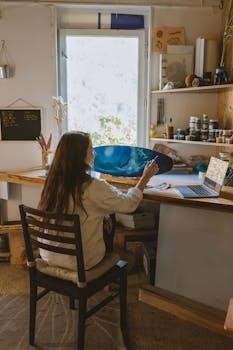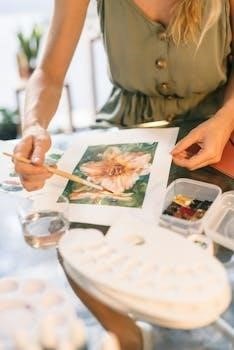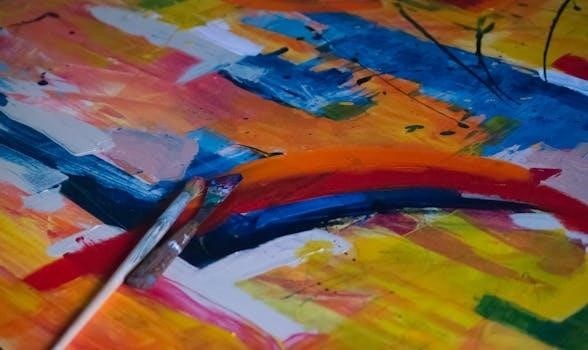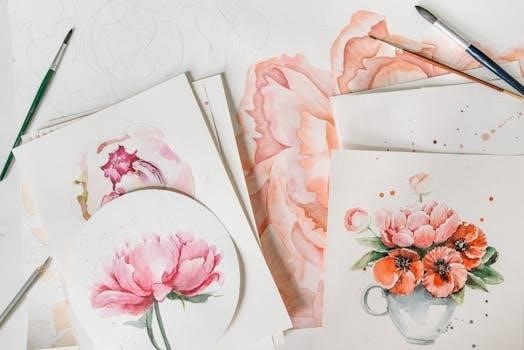Watercolor painting, a beautiful medium, emphasizes reserving whites by leaving the paper unpainted for light tones. It is a unique way to create stunning art. Learning basic watercolor techniques is key for beginners, with tutorials available online. These tutorials guide you through different approaches, from basic to advanced.
What is Watercolor Painting?
Watercolor painting is a transparent painting technique where pigments are suspended in a water-based solution. The most distinctive aspect of watercolor lies in its use of the paper’s white surface to create highlights and light areas, rather than using opaque white paint. This approach requires a different way of thinking compared to other painting mediums. Artists often reserve these white areas by painting around them or employing masking techniques. Watercolor relies heavily on the interaction between water and pigment, allowing for beautiful, fluid effects. The transparency of watercolors allows for layering and blending, and creating unique luminous effects. Mastering watercolor involves understanding how the medium behaves, from its wet-on-wet and wet-on-dry techniques to the use of washes, glazing, and various special effects. It’s a technique that rewards patience and experimentation, encouraging artists to explore its unique characteristics.

Basic Watercolor Techniques
Fundamental to watercolor are wet-on-wet and wet-on-dry techniques. These form the basis for many applications and effects. Understanding when and how to use them is crucial for successful painting.
Wet-on-Wet Technique
The wet-on-wet technique involves applying wet paint onto a wet surface, typically wet paper. This method is ideal for creating soft, blended effects and is often used for backgrounds, skies, and other areas where smooth transitions are desired. The paint flows freely and merges with existing wet areas, creating beautiful, diffused color washes. This approach requires a good understanding of water control, as too much water can result in uncontrolled blooming and unwanted backruns. When done correctly, wet-on-wet allows for wonderfully organic and ethereal textures. It is particularly useful for capturing the fluidity and atmospheric qualities in landscapes and floral subjects. It’s a technique that encourages experimentation and the embrace of serendipitous effects. It is important to note the timing and proper amount of water will affect the final result.
Wet-on-Dry Technique
The wet-on-dry technique involves applying wet paint onto a dry surface, typically dry paper. This approach is ideal for creating sharp lines, precise details, and controlled shapes. Unlike the wet-on-wet method, the paint does not spread as much, allowing for more defined edges. This makes it excellent for adding details like leaves, branches, or architectural elements. The wet-on-dry technique is also useful for layering colors, where each layer dries before the next one is applied, preventing the colors from mixing and muddling. This method provides more control over the paint, making it suitable for creating intricate patterns and designs. The distinct edges achievable with wet-on-dry are often used to create focal points and define shapes within a composition. It’s a fundamental technique that provides essential precision and clarity to your watercolor work. This technique is crucial for achieving accuracy and detail in watercolor painting.
Dry Brush Technique
The dry brush technique is a method where you use a brush with very little water, creating a textured, broken effect. You load your brush with paint but then remove most of the moisture, leaving only a small amount of pigment. When you drag the brush across the paper, it creates a broken, scratchy line rather than a smooth wash; This is great for depicting things such as rough bark, fur, or rocks. It can also be used to create the illusion of texture and depth in a painting. The dry brush technique is especially useful for adding highlights and details to your artwork. It contrasts nicely with smoother washes and can give your painting a more dynamic and interesting feel. The light, broken strokes that come from the technique add a unique element to your art, and is essential in the watercolor artist’s toolkit. Mastering this technique will help you achieve a diverse range of textures and effects, enhancing your paintings.

Essential Techniques for Beginners
For beginners, mastering flat and graded washes is crucial. These techniques involve applying even layers of color. Flat washes create uniform color, while graded washes transition smoothly. These are fundamental to watercolor painting.
Flat Wash Technique
The flat wash technique is a foundational skill in watercolor painting, essential for creating smooth, even areas of color. To achieve a successful flat wash, start by wetting the paper with clean water, ensuring an even sheen without puddles. Load your brush with a consistent mix of watercolor paint and water, maintaining a fluid consistency. Apply the paint in a series of overlapping strokes, working quickly across the desired area while keeping the brush consistently loaded. Avoid letting the edges dry to prevent hard lines, known as “backruns.” If the wash starts to dry unevenly, reload your brush and continue working. This technique is perfect for backgrounds, skies, or any area requiring a uniform tone. Consistent practice is the key to mastering the flat wash, and it will greatly improve your paintings.
Graded Wash Technique
The graded wash technique is a fundamental skill in watercolor, allowing artists to create smooth transitions of color or value. This technique involves creating a wash that gradually changes from dark to light, or from one color to another. To begin, load your brush with a rich, saturated mix of paint. Apply the first stroke at the top of the intended area, and then continue working downward, gradually adding water to the paint mixture with each subsequent stroke. The addition of water dilutes the paint, creating the gradient effect. Alternatively, you can start with a light tone and add more pigment as you move down the page. The key is to work quickly and maintain a wet edge, blending each new stroke into the previous one smoothly, avoiding hard edges. This technique is ideal for painting skies, landscapes, or any area where you want to show depth and form.

Advanced Watercolor Techniques
Once you have grasped the basics, exploring advanced techniques like glazing and masking can significantly enhance your art. These methods, often featured in tutorials, add depth and complexity to watercolor paintings.
Glazing Technique
Glazing, an advanced watercolor technique, involves layering transparent washes of paint over previously dried layers. This method allows artists to build up color intensity and create subtle shifts in hue and value. Each new layer interacts with the underlying colors, resulting in a rich, luminous effect. This technique requires patience, as each layer must be completely dry before applying the next to prevent colors from muddying. Glazing is particularly useful for achieving depth and dimension in a painting and creating a sense of atmosphere. By carefully layering different colors and values, artists can achieve nuanced and complex results. Mastering this technique can significantly elevate the quality and visual interest of watercolor artwork, as shown in many tutorials which demonstrate how to effectively use this method.
Masking Techniques
Masking techniques in watercolor painting are essential for preserving areas of the paper that you want to remain white or a specific color. These methods involve using materials like masking fluid or masking tape to create a barrier, preventing paint from reaching certain sections of the artwork. Masking fluid, when dry, acts as a temporary resist, which can be removed after painting. Masking tape is suitable for creating hard edges and defined shapes. These techniques are very useful for achieving crisp details and controlling the flow of paint, especially for areas that require fine lines or intricate patterns. Learning to effectively use masking techniques opens up possibilities for more complex compositions and allows artists to create intricate designs and precise shapes, enhancing the visual impact of their watercolor artwork.

Special Effects Techniques
Explore unique textures with salt, sponging, and splattering. These methods add depth and interest to your watercolor art. Using salt creates a speckled effect, while sponging and splattering offer varied textural options.
Salt Technique
The salt technique is a fascinating way to introduce unique textures into your watercolor paintings. It works by sprinkling salt onto a wet wash of paint. As the paint dries, the salt absorbs the moisture, creating interesting crystalline patterns. The size of the salt grains will influence the effect, with larger grains producing bigger, more pronounced patterns, while finer salt will result in more subtle, delicate textures. This method is particularly effective when used on areas of a painting where you want to add a sense of visual interest or simulate a granular effect. Experimenting with different types of salt and varying the amount you apply can lead to a wide range of captivating results. It is an excellent technique for adding unexpected and beautiful textures to your art, transforming simple washes into visually dynamic surfaces.
Sponging and Splattering
Sponging and splattering are dynamic techniques that add texture and energy to watercolor paintings. Sponging involves using a sponge, either natural or synthetic, to apply paint to the paper. This creates a mottled effect, perfect for suggesting foliage, clouds, or other textural elements. Varying the pressure and amount of paint on the sponge will produce different results, from light, airy textures to more dense, concentrated patterns. Splattering, on the other hand, is a more spontaneous technique where paint is flicked or spattered onto the paper using a brush. This creates a random, energetic effect, ideal for adding a sense of movement or sparkle. Experiment with different brush sizes and paint consistencies to control the size and intensity of the splatters. These techniques offer a great way to loosen up your painting and introduce unexpected and exciting visual elements.